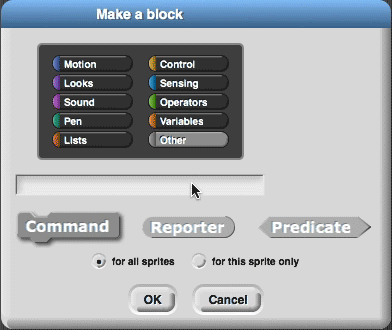-
snap has a "greater than" operator (
>), an "equal" operator (=), and a "less than" operator (<) built in, but doesn't have a "greater than or equal to" (>=) operator.


Build
 and test it well to make sure it does what you expect.
and test it well to make sure it does what you expect.
- When you type the block's title in the Make a block dialog, choose the hexagonal predicate block shape.
- To set the block's name
>=between the two input slots, use the left plus sign in the Block Editor.
-
You may find one or more of these Boolean operators helpful:

There are several correct ways to do this! As long as your block gives the right
trueandfalseanswers, it's correct. -
Build a predicate that tests to see if its input is an integer.
.png)
.png)
You may find
 useful.
useful. -
Build a block that tells whether a given number is between two other given numbers.
.png)
.png) . You can decide whether "between," for your purposes, will include the two boundary numbers or not.
. You can decide whether "between," for your purposes, will include the two boundary numbers or not.
- Write a
 block that reports whether a given day is a weekend. Let's assume that only Saturday and Sunday are part of the weekend.
block that reports whether a given day is a weekend. Let's assume that only Saturday and Sunday are part of the weekend. - Write a
 block. You could write this without your
block. You could write this without your  block, but it'll be much easier (and cleaner code!) if you use
block, but it'll be much easier (and cleaner code!) if you use  as part of this new block.
as part of this new block.
 that stand in between their two inputs are called infix operators. Operators like
that stand in between their two inputs are called infix operators. Operators like